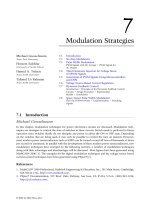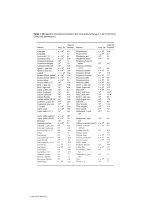Trigonometry handbook
Bạn đang xem bản rút gọn của tài liệu. Xem và tải ngay bản đầy đủ của tài liệu tại đây (4.81 MB, 109 trang )
Math Handbook
of Formulas, Processes and Tricks
(www.mathguy.us)
Trigonometry
Prepared by: Earl L. Whitney, FSA, MAAA
Version 2.2
June 12, 2018
Copyright 2012‐2018, Earl Whitney, Reno NV. All Rights Reserved
Note to Students
This Trigonometry Handbook was developed primarily through work with a number of High
School and College Trigonometry classes. In addition, a number of more advanced topics have
been added to the handbook to whet the student’s appetite for higher level study.
One of the main reasons why I wrote this handbook was to encourage the student to wonder;
to ask “what about …” or “what if …”. I find that students are so busy today that they don’t
have the time, or don’t take the time, to seek out the beauty and majesty that exists in
Mathematics. And, it is there, just below the surface. So be curious and go find it.
The answers to most of the questions below are inside this handbook, but are seldom taught.
Is there a method I can learn that will help me recall the key points on a unit circle
without memorizing the unit circle?
What’s the fastest way to graph a Trig function?
Can I convert the sum of two trig functions to a product of trig functions? How about
the other way around, changing a product to a sum?
Is there an easy way to calculate the area of a triangle if I am given its vertices as points
on a Cartesian plane?
Don’t some of the Polar graphs in Chapter 9 look like they have been drawn with a
Spirograph? Why is that?
A cycloid is both a brachistochrone and a tautochrone. What are these and why are
they important? (you will have to look this one up, but it is well worth your time)
What is a vector cross product and how is it used?
How do the properties of vectors extend to 3 dimensions, where they really matter?
Additionally, ask yourself:
What trig identities can I create that I have not yet seen?
What Polar graphs can I create by messing with trig functions? What makes a pretty
graph instead of one that just looks messed up?
Can I come up with a simpler method of doing things than I am being taught?
What problems can I come up with to stump my friends?
Those who approach math in this manner will be tomorrow’s leaders. Are you one of them?
Please feel free to contact me at if you have any questions or
comments.
Thank you and best wishes!
Earl
Version 2.2
Cover art by Rebecca Williams,
Twitter handle: @jolteonkitty
Page 2 of 109
www.pdfgrip.com
June 12, 2018
TrigonometryHandbook
TableofContents
Page
Description
8
9
9
9
9
9
10
11
11
11
12
13
14
Chapter 1: Functions and Special Angles
Introduction
Angle Definitions
Function Definitions on the x‐ and y‐ Axes
Pythagorean Identities
Sine‐Cosine Relationship
Key Angles in Radians and Degrees
Cofunctions
Unit Circle
Function Definitions in a Right Triangle
SOH‐CAH‐TOA
Trigonometric Functions of Special Angles
Trigonometric Function Values in Quadrants II, III, and IV
Problems Involving Trig Function Values in Quadrants II, III, and IV
Problems Involving Angles of Depression and Inclination
15
17
19
20
22
24
26
28
30
32
Chapter 2: Graphs of Trig Functions
Basic Trig Functions
Characteristics of Trigonometric Function Graphs
Table of Trigonometric Function Characteristics
Sine Function
Cosine Function
Tangent Function
Cotangent Function
Secant Function
Cosecant Function
Application: Simple Harmonic Motion
33
33
34
35
Chapter 3: Inverse Trigonometric Functions
Definitions
Principal Values and Ranges
Graphs of Inverse Trig Functions
Problems Involving Inverse Trigonometric Functions
7
Version 2.2
Page 3 of 109
www.pdfgrip.com
June 12, 2018
TrigonometryHandbook
TableofContents
Page
Description
37
38
41
41
41
42
Chapter 4: Key Angle Formulas
Angle Addition, Double Angle, Half Angle Formulas
Examples
Power Reducing Formulas
Product‐to‐Sum Formulas
Sum‐to‐Product Formulas
Examples
43
44
47
48
Chapter 5: Trigonometric Identities and Equations
Verifying Identities
Verifying Identities ‐ Techniques
Solving Trigonmetic Equations
Solving Trigonmetic Equations ‐ Examples
51
52
53
54
56
57
59
60
Chapter 6: Solving an Oblique Triangle
Summary of Methods
Laws of Sines and Cosines
Laws of Sines and Cosines ‐ Examples
The Ambiguous Case
Flowchart for the Ambiguous Case
Ambiguous Case ‐ Examples
Bearings
Bearings ‐ Examples
61
61
62
62
63
Chapter 7: Area of a Triangle
Geometry Formula
Heron's Formula
Trigonometric Formulas
Coordinate Geometry Formula
Examples
64
64
65
65
67
68
Chapter 8: Polar Coordinates
Introduction
Conversion between Rectangular and Polar Coordinates
Expressing Complex Numbers in Polar Form
Operations on Complex Numbers in Polar Form
DeMoivre's Theorem
DeMoivre's Theorem for Roots
Version 2.2
Page 4 of 109
www.pdfgrip.com
June 12, 2018
TrigonometryHandbook
TableofContents
Page
Description
69
69
70
70
71
74
75
76
77
Chapter9:PolarFunctions
PartsofthePolarGraph
Symmetry
GraphingMethods
GraphingwiththeTI84PlusCalculator
GraphTypes(Circles,Roses,Limaỗons,Lemniscates,Spirals)
Rose
Cardioid
ConvertingBetweenPolarandRectangularFormsofEquations
ParametricEquations
79
79
79
80
81
83
84
86
86
86
87
90
92
Chapter10:Vectors
Introduction
SpecialUnitVectors
VectorComponents
VectorProperties
VectorPropertiesExamples
DotProduct
DotProductExamples
VectorProjection
OrthogonalComponentsofaVector
Work
ApplicationsofVectorsExamples
VectorCrossProduct
VectorTripleProducts
93
103
105
Appendices
AppendixASummaryofTrigonometricFormulas
AppendixBSolvingTheAmbiguousCaseAlternativeMethod
AppendixCSummaryofPolarandRectangularForms
106
Index
Version 2.2
Page 5 of 109
www.pdfgrip.com
June 12, 2018
TrigonometryHandbook
TableofContents
Useful Websites
Mathguy.us – Developed specifically for math students from Middle School to College, based
on the author's extensive experience in professional mathematics in a business setting and in
math tutoring. Contains free downloadable handbooks, PC Apps, sample tests, and more.
/>
Wolfram Math World – Perhaps the premier site for mathematics on the Web. This site
contains definitions, explanations and examples for elementary and advanced math topics.
/>
Khan Academy – Supplies a free online collection of thousands of micro lectures via YouTube
on numerous topics. It's math and science libraries are extensive.
www.khanacademy.org
Analyze Math Trigonometry – Contains free Trigonometry tutorials and problems. Uses Java
applets to explore important topics interactively.
/>
Schaum’s Outline
An important student resource for any high school or college math student is a Schaum’s
Outline. Each book in this series provides explanations of the various topics in the course and
a substantial number of problems for the student to try. Many of the problems are worked
out in the book, so the student can see examples of how they should be solved.
Schaum’s Outlines are available at Amazon.com, Barnes & Noble and other booksellers.
Version 2.2
Page 6 of 109
www.pdfgrip.com
June 12, 2018
Chapter 1
Functions and Special Angles
Introduction
What is Trigonometry?
The word “Trigonometry” comes from the Greek “trigonon” (meaning triangle)
and “metron” (meaning measure). So, simply put, Trigonometry is the study of
the measures of triangles. This includes the lengths of the sides, the measures
of the angles and the relationships between the sides and angles.
The modern approach to Trigonometry also deals with how right triangles interact with circles,
especially the Unit Circle, i.e., a circle of radius 1. Although the basic concepts are simple, the
applications of Trigonometry are far reaching, from cutting the required angles in kitchen tiles to
determining the optimal trajectory for a rocket to reach the outer planets.
Radians and Degrees
Angles in Trigonometry can be measured in either radians or degrees:
There are 360 degrees i.e., 360° in one rotation around a circle. Although there are various
accounts of how a circle came to have 360 degrees, most of these are based on the fact that
early civilizations considered a complete year to have 360 days.
There are 2 ~6.283 radians in one rotation around a circle. The
ancient Greeks defined to be the ratio of the circumference of a
circle to its diameter (i.e.,
). Since the diameter is double the
radius, the circumference is 2 times the radius (i.e.,
2 ). One
radian is the measure of the angle made from wrapping the radius of a
circle along the circle’s exterior.
r
1rad
r
Measure of an Arc
One of the simplest and most basic formulas in Trigonometry provides the measure of an arc in terms
of the radius of the circle, , and the arc’s central angle θ, expressed in radians. The formula is easily
derived from the portion of the circumference subtended by θ.
Since there are 2 radians in one full rotation around the circle, the measure
of an arc with central angle θ, expressed in radians, is:
∙
θ
2
2
∙
θ
2
so
Version 2.2
Page 7 of 109
www.pdfgrip.com
June 12, 2018
Chapter 1
Functions and Special Angles
Angle Definitions
Basic Definitions
A few definitions relating to angles are useful when beginning the study of Trigonometry.
Angle: A measure of the space between rays with a common endpoint. An angle is typically
measured by the amount of rotation required to get from its initial
side to its terminal side.
Initial Side: The side of an angle from which its rotational
measure begins.
Terminal Side: The side of an angle at which its rotational
measure ends.
Vertex: The vertex of an angle is the common endpoint of the two rays that define the angle.
Definitions in the Cartesian (
) Plane
When angles are graphed on a coordinate
system (Rectangular or Polar), a number of
additional terms are useful.
Standard Position: An angle is in standard
position if its vertex is the origin (i.e., the
point 0, 0 ) and its initial side is the
positive ‐axis.
Polar Axis: The Polar Axis is the positive ‐axis. It is the initial side of all angles in standard position.
Polar Angle: For an angle in standard position, its polar angle is the angle measured from the polar
axis to its terminal side. If measured in a counter‐clockwise direction, the polar angle is positive; if
measured in a clockwise direction, the polar angle is negative.
Reference Angle: For an angle in standard position, its reference angle is the angle between 0° and
90° measured from the ‐axis (positive or negative) to its terminal side. The reference angle can be
0°; it can be 90°; it is never negative.
Coterminal Angle: Two angles are coterminal if they are in standard position and have the same
terminal side. For example, angles of measure 50° and 410° are coterminal because 410° is one full
rotation around the circle (i.e., 360°), plus 50°, so they have the same terminal side.
Quadrantal Angle: An angle in standard position is a quadrantal angle if its terminal side lies on
either the ‐axis or the ‐axis.
Version 2.2
Page 8 of 109
www.pdfgrip.com
June 12, 2018
Chapter 1
Functions and Special Angles
Trigonometric Functions
Trigonometric Functions
(on the ‐ and ‐axes)
Pythagorean Identities
(for any angle θ)
sin cos
1
sec
1 tan
csc
1
cot
sin θ
sin θ
1
csc θ
cos θ
cos θ
1
sec θ
tan θ
tan θ
1
tan θ
cot θ
sin θ
cos θ
cot θ
cot θ
1
cot θ
tan θ
cos θ
sin θ
sec θ
sec θ
1
cos θ
csc θ
csc θ
1
sin θ
Sine‐Cosine Relationship
sin θ
sin θ
cos θ
2
Key Angles
(
°
0°
cos θ
2
30°
60°
sin
cos
tan
cot
sec
csc
Version 2.2
2
⇔ cos
90°
2
⇔ cot
2
⇔ csc
sin
tan
sec
2
0radians
45°
Cofunctions (in Quadrant I)
)
6
4
3
2
radians
radians
radians
radians
2
2
Page 9 of 109
www.pdfgrip.com
June 12, 2018
Chapter 1
Functions and Special Angles
The Unit Circle
The Unit Circle diagram below provides ‐ and ‐values on a circle of radius 1 at key angles. At any
point on the unit circle, the ‐coordinate is equal to the cosine of the angle and the ‐coordinate is
equal to the sine of the angle. Using this diagram, it is easy to identify the sines and cosines of angles
that recur frequently in the study of Trigonometry.
Version 2.2
Page 10 of 109
www.pdfgrip.com
June 12, 2018
Chapter 1
Functions and Special Angles
Trigonometric Functions and Special Angles
Trigonometric Functions (Right Triangle)
SOH‐CAH‐TOA
sin
cos
tan
Special Angles
Radians
0
sin
cos
cos
tan
tan
Trig Functions of Special Angles ( )
Degrees
0⁰
√
45⁰
√
60⁰
√
90⁰
√
30⁰
√
sin
√
√
√
√
√
√
√
√
√
√
√
√
√
√
√
undefined
Note the patterns in the above table: In the sine column, the numbers 0 to 4 occur in sequence
under the radical! The cosine column is the sine column reversed. Tangent sine cosine.
Version 2.2
Page 11 of 109
www.pdfgrip.com
June 12, 2018
Chapter 1
Functions and Special Angles
Trigonometric Function Values in Quadrants II, III, and IV
In quadrants other than Quadrant I, trigonometric values for angles are calculated in the following
manner:
Draw the angle θ on the Cartesian Plane.
Calculate the measure of the reference angle
from the ‐axis to θ.
Find the value of the trigonometric function of
the angle in the previous step.
Assign a “ ” or “ “ sign to the trigonometric
value based on the function used and the
quadrant θ is in (from the table at right).
Examples:
Θ in Quadrant II – Calculate: 180⁰
∠
120⁰, the reference angle is 180°
For
sin 60°
√
, so:
120°
60°
√
°
Θ in Quadrant III – Calculate:
∠
180⁰
For
210⁰, the reference angle is 210°
√
cos 30° √ , so:
°
180°
30°
Θ in Quadrant IV – Calculate: 360⁰
315⁰, the reference angle is 360°
For
tan 45°
1, so:
Version 2.2
∠
315°
45°
°
Page 12 of 109
www.pdfgrip.com
June 12, 2018
Chapter 1
Functions and Special Angles
Problems Involving Trig Function Values in Quadrants II, III, and IV
A typical problem in Trigonometry is to find the value of one or more Trig functions based on a set of
constraints. Often, the constraints involve the value of another Trig function and the sign of yet a
third Trig Function. The key to solving this type of problem is to draw the correct triangle in the
correct quadrant.
A couple of examples will illustrate this process.
Example 1.1: sin
, tan
0. Find the values of sec and cot .
0 , tan
Notice that sin
0. Therefore, is in 3, so we draw the angle in that quadrant.
In 3, is negative; is always positive. Since sin
2,
, we let
3.
Using the Pythagorean Theorem, we calculate the length of the horizontal
leg of the triangle: 3
2
√5. Since the angle is in 3, is
√5.
negative, so we must have
Then, sec
And, cot
√
√
√
√
Example 1.2: cot
, cos
Notice that cot
0. Find the value of csc and cos .
0 , cos
0. Therefore, is in 2, so we draw the angle in that quadrant.
In 2, is negative, and is positive. Since cot
, we let
9,
4.
Using the Pythagorean Theorem, we can calculate the length of the
9
hypotenuse of the triangle:
Then, csc
And, cos
Version 2.2
√
√
√
4
√97.
Page 13 of 109
www.pdfgrip.com
June 12, 2018
Chapter 1
Functions and Special Angles
Problems Involving Angles of Depression and Inclination
A common problem in Trigonometry deals with angles of depression or inclination. An angle of
depression is an angle below the horizontal at which an observer must look to see an object. An
angle of inclination is an angle above the horizontal at which an observer must look to see an object.
Example 1.3: A building 185 feet tall casts a 60 foot long shadow. If a person looks down from the
top of the building, what is the measure of the angle of depression? Assume the person's eyes are 5
feet above the top of the building.
The total height from which the person looks down upon the shadow is: 185 5
begin by drawing the diagram below, then consider the trigonometry involved.
tan x°
60
190
0.3158
0.3158
tan
190 ft. We
17.5°
The angle of depression is the complement of °.
θ
90°
17.5°
72.5°
Example 1.4: A ship is 300 meters from a vertical cliff. The navigator uses a sextant to determine the
angle of inclination from the deck of the ship to the top of the cliff to be 62.4°. How far above the
deck of the ship is the top of the cliff? What is the distance from the deck to the top of the cliff?
We begin by drawing the diagram below, then consider the trigonometry involved.
a) To find how far above the deck the top of the cliff is ( ):
tan 62.4°
300
300 tan 62.4°
573.8 meters
b) To find the distance from the deck to the top of the cliff ( ):
300
cos 62.4°
. °
647.5 meters
Version 2.2
Page 14 of 109
www.pdfgrip.com
June 12, 2018
Chapter 2
Graphs of Trig Functions
Graphs of Basic (Parent) Trigonometric Functions
The sine and cosecant functions are reciprocals. So:
sin
1
csc
and
csc
1
sin
The cosine and secant functions are reciprocals. So:
cos
1
sec
and
sec
1
cos
The tangent and cotangent functions are reciprocals. So:
tan
Version 2.2
1
cot
and
cot
Page 15 of 109
www.pdfgrip.com
1
tan
June 12, 2018
Chapter 2
Graphs of Trig Functions
Graphs of Basic (Parent) Trigonometric Functions
It is instructive to view the parent trigonometric functions on the same axes as their reciprocals.
Identifying patterns between the two functions can be helpful in graphing them.
Looking at the sine and cosecant functions,
we see that they intersect at their maximum
and minimum values (i.e., when
1). The
vertical asymptotes (not shown) of the
cosecant function occur when the sine
function is zero.
Looking at the cosine and secant functions,
we see that they intersect at their maximum
and minimum values (i.e., when
1). The
vertical asymptotes (not shown) of the secant
function occur when the cosine function is
zero.
Looking at the tangent and cotangent
functions, we see that they intersect when
sin
cos (i.e., at
, an
integer). The vertical asymptotes (not
shown) of the each function occur when the
other function is zero.
Version 2.2
Page 16 of 109
www.pdfgrip.com
June 12, 2018
Chapter 2
Graphs of Trig Functions
Characteristics of Trigonometric Function Graphs
All trigonometric functions are periodic, meaning that they repeat the pattern of the curve (called a
cycle) on a regular basis. The key characteristics of each curve, along with knowledge of the parent
curves are sufficient to graph many trigonometric functions. Let’s consider the general function:
A∙
where A, B, C and D are constants and “
tangent, cotangent, secant, cosecant).
B
C
D
” is any of the six trigonometric functions (sine, cosine,
Amplitude
Amplitude is the measure of the distance of peaks and troughs
from the midline (i.e., center) of a sine or cosine function;
amplitude is always positive. The other four functions do not
have peaks and troughs, so they do not have amplitudes. For
the general function,
, defined above, amplitude |A|.
Period
Period is the horizontal width of a single cycle or wave, i.e., the distance it travels before it repeats.
Every trigonometric function has a period. The periods of the parent functions are as follows: for
sine, cosine, secant and cosecant, period 2π; for tangent and cotangent, period π.
For the general function,
period
, defined above,
.
Frequency
Frequency is most useful when used with the sine and
cosine functions. It is the reciprocal of the period, i.e.,
frequency
.
Frequency is typically discussed in relation to the sine and cosine functions when considering
harmonic motion or waves. In Physics, frequency is typically measured in Hertz, i.e., cycles per
second. 1 Hz 1 cycle per second.
For the general sine or cosine function,
Version 2.2
, defined above, frequency
Page 17 of 109
www.pdfgrip.com
.
June 12, 2018
Chapter 2
Graphs of Trig Functions
Phase Shift
Phase shift is how far has the function been shifted horizontally
(left or right) from its parent function. For the general function,
, defined above,
phaseshift
.
A positive phase shift indicates a shift to the right relative to the
graph of the parent function; a negative phase shift indicates a shift
to the left relative to the graph of the parent function.
A trick for calculating the phase shift is to set the argument of the trigonometric function equal to
zero: B
C
0, and solve for . The resulting value of is the phase shift of the function.
Vertical Shift
Vertical shift is the vertical distance that the midline of a curve lies
above or below the midline of its parent function (i.e., the ‐axis).
For the general function,
, defined above, verticalshift D.
The value of D may be positive, indicating a shift upward, or
negative, indicating a shift downward relative to the graph of the
parent function.
Putting it All Together
The illustration below shows how all of the items described above combine in a single graph.
Version 2.2
Page 18 of 109
www.pdfgrip.com
June 12, 2018
Chapter 2
Graphs of Trig Functions
Summary of Characteristics and Key Points – Trigonometric Function Graphs
Sine
Function:
Cosine
Tangent
Cotangent
Secant
Cosecant
Parent Function
sin
Domain
∞, ∞
cos
tan
∞, ∞ except
∞, ∞
none
, where
none
Range
1, 1
1, 1
∞, ∞
∞, ∞
Period
2
2
, where is an Integer
‐intercepts
(1)
Odd or Even Function
Odd Function
, where
is odd
Even Function
∞, ∞ except
, where
∞, ∞ except ,
where is an Integer
,
is odd
∞, 1 ∪ 1, ∞
, where is an
Integer
∞, 1 ∪ 1, ∞
2
csc
where is odd
, where is an
Integer
is odd
sec
∞, ∞ except ,
where is an Integer
,
where is odd
Vertical Asymptotes
cot
2
midway between
asymptotes
midway between
asymptotes
none
none
Odd Function
Odd Function
Even Function
Odd Function
sin
General Form
Amplitude/Stretch, Period,
Phase Shift, Vertical Shift
when
(2)
2
,
,
cos
| |,
2
,
when
when
when
when
| |,
,
tan
| |,
,
Notes:
(1) An odd function is symmetric about the origin, i.e.
| |,
www.pdfgrip.com
| |,
2
,
,
vertical asymptote
csc
| |,
2
,
,
vertical asymptote
vertical asymptote
. An even function is symmetric about the ‐axis, i.e.,
Page 19 of 109
sec
vertical asymptote
,
vertical asymptote
(2) All Phase Shifts are defined to occur relative to a starting point of the ‐axis (i.e., the vertical line
Version 2.2
,
,
cot
vertical asymptote
vertical asymptote
vertical asymptote
.
0).
June 12, 2018
Chapter 2
Graphs of Trig Functions
Graph of a General Sine Function
General Form
The general form of a sine function is:
.
In this equation, we find several parameters of the function which will help us graph it. In particular:
| |. The amplitude is the magnitude of the stretch or compression of the
Amplitude:
function from its parent function:
sin .
Period:
. The period of a trigonometric function is the horizontal distance over which
the curve travels before it begins to repeat itself (i.e., begins a new cycle). For a sine or cosine
function, this is the length of one complete wave; it can be measured from peak to peak or
from trough to trough. Note that 2π is the period of
sin .
Phase Shift:
. The phase shift is the distance of the horizontal translation of the
function. Note that the value of in the general form has a minus sign in front of it, just like
. So,
does in the vertex form of a quadratic equation:
o A minus sign in front of the implies a translation to the right, and
o A plus sign in front of the implies a implies a translation to the left.
Vertical Shift:
. This is the distance of the vertical translation of the function. This is
.
equivalent to in the vertex form of a quadratic equation:
Example 2.1:
The midline has the equation y D. In this example, the midline
is: y 3. One wave, shifted to the right, is shown in orange below.
For this example:
;
;
;
| |
Amplitude:
Period:
Phase Shift:
Vertical Shift:
Version 2.2
Page 20 of 109
www.pdfgrip.com
| |
June 12, 2018
Chapter 2
Graphs of Trig Functions
Graphing a Sine Function with No Vertical Shift:
A wave (cycle) of the sine function has three zero points (points on the x‐axis) –
at the beginning of the period, at the end of the period, and halfway in‐between.
Example:
.
Step 1: Phase Shift:
.
The first wave begins at the
point units to the right of
the Origin.
Step 2: Period:
.
,
The point is:
. The first
.
The first wave ends at the
point units to the right of
where the wave begins.
wave ends at the point:
Step 3: The third zero point
is located halfway between
the first two.
The point is:
Step 4: The ‐value of the
point halfway between the
left and center zero points is
" ".
The point is:
Step 5: The ‐value of the
point halfway between the
center and right zero points
The point is:
,
,
,
,
,
,
,
,
is “– ”.
Step 6: Draw a smooth
curve through the five key
points.
This will produce the graph
of one wave of the function.
Step 7: Duplicate the wave
to the left and right as
desired.
Version 2.2
Note: If
0, all points
on the curve are shifted
vertically by units.
Page 21 of 109
www.pdfgrip.com
June 12, 2018
Chapter 2
Graphs of Trig Functions
Graph of a General Cosine Function
General Form
The general form of a cosine function is:
.
In this equation, we find several parameters of the function which will help us graph it. In particular:
| |. The amplitude is the magnitude of the stretch or compression of the
Amplitude:
function from its parent function:
cos .
Period:
. The period of a trigonometric function is the horizontal distance over which
the curve travels before it begins to repeat itself (i.e., begins a new cycle). For a sine or cosine
function, this is the length of one complete wave; it can be measured from peak to peak or
from trough to trough. Note that 2π is the period of
cos .
Phase Shift:
. The phase shift is the distance of the horizontal translation of the
function. Note that the value of in the general form has a minus sign in front of it, just like
. So,
does in the vertex form of a quadratic equation:
o A minus sign in front of the implies a translation to the right, and
o A plus sign in front of the implies a implies a translation to the left.
Vertical Shift:
. This is the distance of the vertical translation of the function. This is
.
equivalent to in the vertex form of a quadratic equation:
Example 2.2:
The midline has the equation y D. In this example, the midline
is: y 3. One wave, shifted to the right, is shown in orange below.
For this example:
;
;
;
| |
Amplitude:
Period:
Phase Shift:
Vertical Shift:
Version 2.2
Page 22 of 109
www.pdfgrip.com
| |
June 12, 2018
Chapter 2
Graphs of Trig Functions
Graphing a Cosine Function with No Vertical Shift:
A wave (cycle) of the cosine function has two maxima (or minima if
0) –
one at the beginning of the period and one at the end of the period – and a
minimum (or maximum if
0) halfway in‐between.
Example:
.
Step 1: Phase Shift:
.
The first wave begins at the
point units to the right of
the point , .
Step 2: Period:
,
,
The point is:
. The first
.
The first wave ends at the
point units to the right of
where the wave begins.
wave ends at the point:
Step 3: The ‐value of the
point halfway between those
in the two steps above is
"
".
The point is:
Step 4: The ‐value of the
point halfway between the
left and center extrema is
" ".
The point is:
Step 5: The ‐value of the
point halfway between the
center and right extrema is
" ".
The point is:
,
Step 6: Draw a smooth
curve through the five key
points.
,
,
,
,
,
,
This will produce the graph
of one wave of the function.
Step 7: Duplicate the wave
to the left and right as
desired.
Version 2.2
,
Note: If
0, all points
on the curve are shifted
vertically by units.
Page 23 of 109
www.pdfgrip.com
June 12, 2018
Chapter 2
Graphs of Trig Functions
Graph of a General Tangent Function
General Form
The general form of a tangent function is:
.
In this equation, we find several parameters of the function which will help us graph it. In particular:
Scale factor: | |. The tangent function does not have amplitude. | | is the magnitude of the
stretch or compression of the function from its parent function:
tan .
Period:
. The period of a trigonometric function is the horizontal distance over which
the curve travels before it begins to repeat itself (i.e., begins a new cycle). For a tangent or
cotangent function, this is the horizontal distance between consecutive asymptotes (it is also
the distance between ‐intercepts). Note that π is the period of
tan .
Phase Shift:
. The phase shift is the distance of the horizontal translation of the
function. Note that the value of in the general form has a minus sign in front of it, just like
does in the vertex form of a quadratic equation:
. So,
o A minus sign in front of the implies a translation to the right, and
o A plus sign in front of the implies a implies a translation to the left.
Vertical Shift:
. This is the distance of the vertical translation of the function. This is
.
equivalent to in the vertex form of a quadratic equation:
Example 2.3:
The midline has the equation y D. In this example, the midline
is: y 3. One cycle, shifted to the right, is shown in orange below.
Note that, for the
tangent curve, we
typically graph half
of the principal
cycle at the point
of the phase shift,
and then fill in the
other half of the
cycle to the left
(see next page).
Version 2.2
For this example:
;
;
;
Scale Factor: | |
Period:
| |
Phase Shift:
Vertical Shift:
Page 24 of 109
www.pdfgrip.com
June 12, 2018
Chapter 2
Graphs of Trig Functions
Graphing a Tangent Function with No Vertical Shift:
A cycle of the tangent function has two asymptotes and a zero point halfway in‐
between. It flows upward to the right if
0 and downward to the right if
Example:
0.
.
Step 1: Phase Shift:
.
The first cycle begins at the
“zero” point units to the
right of the Origin.
Step 2: Period:
.
,
The point is:
.
Place a vertical asymptote
.
beginning of the cycle.
Step 3: Place a vertical
The left asymptote is at:
units to the
left of the beginning of the
cycle.
Step 4: The ‐value of the
point halfway between the
zero point and the right
asymptote is " ".
The point is:
Step 5: The ‐value of the
point halfway between the
left asymptote and the zero
point is "
".
The point is:
Step 6: Draw a smooth
curve through the three key
points, approaching the
asymptotes on each side.
,
,
,
,
This will produce the graph
of one cycle of the function.
Step 7: Duplicate the cycle
to the left and right as
desired.
Version 2.2
.
The right asymptote is at:
units to the right of the
asymptote
Note: If
0, all points
on the curve are shifted
vertically by units.
Page 25 of 109
www.pdfgrip.com
June 12, 2018









